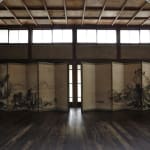Soga Shōhaku (1730–1781)
Landscape in Ink
Ink on paper, pair of six-folding screens
Seals: Meirinsai; Jasokuken Shohaku; Meiyu; Kiitsu
168 x 367 cm each (overall)
Seals: Meirinsai; Jasokuken Shohaku; Meiyu; Kiitsu
168 x 367 cm each (overall)
Further images
-
(View a larger image of thumbnail 1
)

-
(View a larger image of thumbnail 2
)

-
(View a larger image of thumbnail 3
)

-
(View a larger image of thumbnail 4
)

-
(View a larger image of thumbnail 5
)

-
(View a larger image of thumbnail 6
)

-
(View a larger image of thumbnail 7
)

-
(View a larger image of thumbnail 8
)

This pair of folding screens are painted almost in shin, or formal, style. A pavilion on the boulder in the left screen, however, is rendered with a swift brush, which resembles the so, or informal, style of Kaiho Yusho (1533–1615). A similarly brushed pavilion is seen in the folding screen Chinese Scholar Contemplating a Waterfall by Shohaku in the Metropolitan Museum of Art. The brush work, boldly applied to the rocks with a wide brush, is also observed in the fusuma (sliding panels) painting Eight Views of the Xiao-Xiang in the Mie Prefectural Art Museum (hereinafter the “Mie fusuma”) and the folding screens Chinese Recluses in the Tokyo National Museum (hereinafter the “TNM screen”). The present screen resembles more to the TNM screens, for the more stylized depiction of rocks. They are also signed in the same style and share two same seals. These two screens probably postdate the Mie fusuma, which is believed to have been painted around 1764, when Shohaku visited Ise, the present Mie Prefecture.
It is speculated that the TNM screens were painted in the same period as the fusuma painting Landscape with Pavilions by Shohaku in the residence of the Osumi family (hereinafter the “Osumi fusuma”), which is thought to have been painted in the early An’ei period (1772–1781). However, the expression of rocks in the Osumi fusuma is more stylized than the TNM screens, resembling that of the hanging scroll Orchid Pavilion Gathering in the Cleveland Museum of Art, which is dated 1777 by the artist. The present screens and the TNM screens, probably preceding the Osumi fusuma, can be tentatively dated to the late Meiwa period (1764–1772), when Shohaku was around forty years old. Some parts of the right screen are partially repaired, and a gentleman on the veranda and part of the thatched roof hut are retouched.
Soga Shohaku (painter; 1730–1781)
Also known as Miura Teruo; Terukazu; Terutaka; Shiru; Sakonjiro; Jasokuken; Kishinsai, Joki; etc.
Kyoto-born painter. Learned painting under Takada Keiho, and named himself “Soga Jasoku X” for his admiration for the Muromachi Period ink painting. Distinguished for his radical subject, unconventional composition and dynamic brushstrokes. Close to Ike no Taiga, and left a great many anecdotes due to his eccentric character.
It is speculated that the TNM screens were painted in the same period as the fusuma painting Landscape with Pavilions by Shohaku in the residence of the Osumi family (hereinafter the “Osumi fusuma”), which is thought to have been painted in the early An’ei period (1772–1781). However, the expression of rocks in the Osumi fusuma is more stylized than the TNM screens, resembling that of the hanging scroll Orchid Pavilion Gathering in the Cleveland Museum of Art, which is dated 1777 by the artist. The present screens and the TNM screens, probably preceding the Osumi fusuma, can be tentatively dated to the late Meiwa period (1764–1772), when Shohaku was around forty years old. Some parts of the right screen are partially repaired, and a gentleman on the veranda and part of the thatched roof hut are retouched.
Soga Shohaku (painter; 1730–1781)
Also known as Miura Teruo; Terukazu; Terutaka; Shiru; Sakonjiro; Jasokuken; Kishinsai, Joki; etc.
Kyoto-born painter. Learned painting under Takada Keiho, and named himself “Soga Jasoku X” for his admiration for the Muromachi Period ink painting. Distinguished for his radical subject, unconventional composition and dynamic brushstrokes. Close to Ike no Taiga, and left a great many anecdotes due to his eccentric character.







